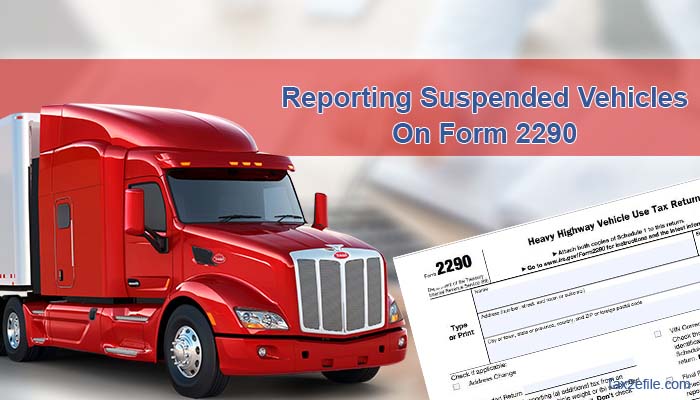- June 5, 2023

Report suspended vehicles suing form 2290 to IRS
Truck owners need not pay tax on vehicles categorized as being suspended. Suspended vehicles are those whose mileage is the minimum to be eligible for taxation. Vehicles that did not meet 5,000 miles’ mileage on the highways and agricultural vehicles that did not meet 7,500 miles are categorized as suspended vehicles.
Table of Contents
Reporting suspended vehicles:
Truck owners should keep meticulous records of the vehicle’s use and mileage if they choose to suspend a vehicle. The IRS requires proof to learn that the car did not exceed its mileage limit. Failing to furnish the evidence can result in costly fines.
Truck owners should report their suspended vehicles in Form 2290. This is the same form the IRS requires to register the highway use tax. For writing the suspended vehicle, the taxpayers will need the following information.
- The Vehicle Identification Number
- The reason for the suspension of the vehicle
- The date at which the suspension began.
- Name and address of the taxpayer
- The Employer Identification Number
- The taxable gross weight of the vehicle
- The beginning and the ending date of the suspension period.
Truck owners can report the suspended vehicle by mail, fax, or e-file. They should file separate Form 2290 for each of the cars they suspend.
Vehicles that naturally come under HVUT Exemption:
Vehicles that naturally come under HVUT exemption are as follows,
- Vehicles of the American Red Cross
- Vehicles belonging to the federal government
- Vehicles used by the Indian Tribal Governments
- Vehicles used by the Local and state governments, including the District of Columbia
- Vehicles of Mass Transportation Authorities
- Vehicles of Non-profit volunteer departments like the fire departments, rescue squads, and ambulances.
Commercial vehicles that have run for 5000 miles or less and agricultural vehicles that have run for 7000 miles or less annually also come under the suspension category. Vehicles that are meant for off-highway transportation. Mobile machinery also comes under the suspended vehicles category. This includes,
- Mobile machinery for non-transportation function
- Non-transportation trailers and semi-trailers
- Blood collection vehicles.
If taxpayers find that the vehicles come under any of these categories and eligibility, they report their heavy vehicles to the IRS and get the HVUT exemption status.
How to file Form 2290 for a Report suspended vehicle?
If you have a vehicle that comes under the suspended vehicle category, you can file HVUT returns through Tax2efile by following these simple steps.
- Login to the Tax2efile account using the registered email address.
- Click on the option ‘amend the existing file.’
- Choose your business information. Create an account if you do not have one.
- Click on ‘Start e-filing.’ Specify the tax period and indicate if this is the final return
- Choose on ‘Mileage exceeded’ option and click on Start.
- Enter the VIN and the gross weight of the vehicle
- Review the details again and click on save.
Bottom Line:
While taxpayers are not required to pay taxes for a suspended vehicle, it is crucial for them to maintain meticulous records of its usage and mileage. By diligently documenting this information, individuals can provide the necessary evidence to the IRS, demonstrating that their vehicle falls under the suspended category. These well-kept records are invaluable in ensuring compliance with tax regulations and avoiding potential issues during tax audits. This helps to avoid penalties if the IRS audits the taxpayer.

